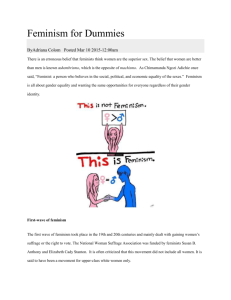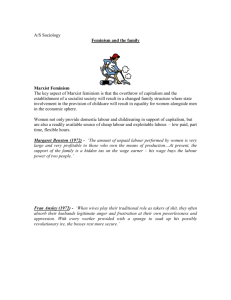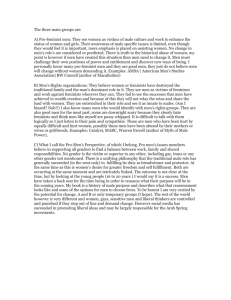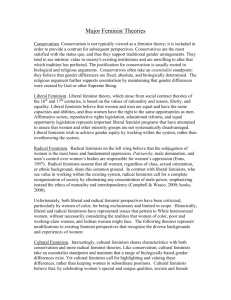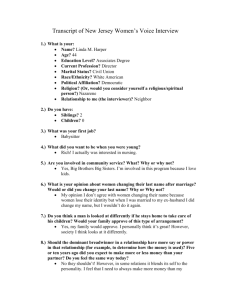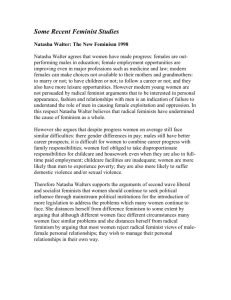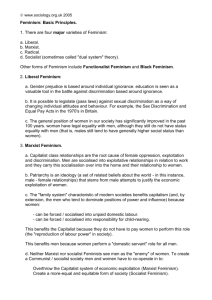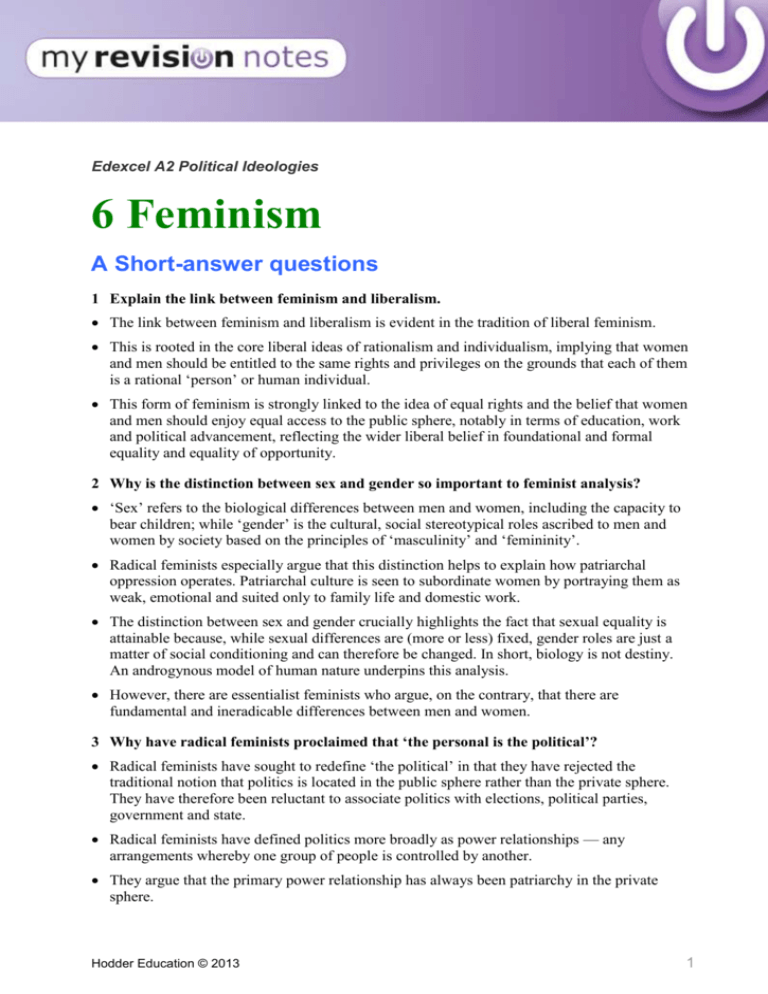
Edexcel A2 Political Ideologies
6 Feminism
A Short-answer questions
1 Explain the link between feminism and liberalism.
The link between feminism and liberalism is evident in the tradition of liberal feminism.
This is rooted in the core liberal ideas of rationalism and individualism, implying that women
and men should be entitled to the same rights and privileges on the grounds that each of them
is a rational ‘person’ or human individual.
This form of feminism is strongly linked to the idea of equal rights and the belief that women
and men should enjoy equal access to the public sphere, notably in terms of education, work
and political advancement, reflecting the wider liberal belief in foundational and formal
equality and equality of opportunity.
2 Why is the distinction between sex and gender so important to feminist analysis?
‘Sex’ refers to the biological differences between men and women, including the capacity to
bear children; while ‘gender’ is the cultural, social stereotypical roles ascribed to men and
women by society based on the principles of ‘masculinity’ and ‘femininity’.
Radical feminists especially argue that this distinction helps to explain how patriarchal
oppression operates. Patriarchal culture is seen to subordinate women by portraying them as
weak, emotional and suited only to family life and domestic work.
The distinction between sex and gender crucially highlights the fact that sexual equality is
attainable because, while sexual differences are (more or less) fixed, gender roles are just a
matter of social conditioning and can therefore be changed. In short, biology is not destiny.
An androgynous model of human nature underpins this analysis.
However, there are essentialist feminists who argue, on the contrary, that there are
fundamental and ineradicable differences between men and women.
3 Why have radical feminists proclaimed that ‘the personal is the political’?
Radical feminists have sought to redefine ‘the political’ in that they have rejected the
traditional notion that politics is located in the public sphere rather than the private sphere.
They have therefore been reluctant to associate politics with elections, political parties,
government and state.
Radical feminists have defined politics more broadly as power relationships — any
arrangements whereby one group of people is controlled by another.
They argue that the primary power relationship has always been patriarchy in the private
sphere.
Hodder Education © 2013
1
Thus they have argued that ‘the personal is the political’, as the domination of men and the
subordination of women in wider society largely stems from unequal gender relations within
the family or in personal or domestic life.
B Essay questions
4 Analyse similarities and differences between liberal feminism and radical feminism.
Radical feminism developed largely out of the belief that liberal feminism had been
ineffective and inadequate because, after over 100 years of liberal feminist theory and
practice, systematic and pervasive inequalities between men and women remained in the
spheres of family roles, work, politics, law, education, pay and social status.
Radical liberals reject the liberal focus upon the public sphere — the pursuit of equal legal
and political rights — because, they say, it ignores or denies the root causes of gender
oppression which lie in the private or domestic sphere. Patriarchy — where the male is head
of the household in the personal and private sphere of home and family — has always been
the first and most important power relationship in the human social system, hence their
famous slogan, ‘The personal is the political’.
This also implies a different interpretation of ‘politics’ from the liberal one. For radical
feminists, ‘politics’ are involved wherever there are power structures and relationships of
conflict, and this is primarily evident within the patriarchal family.
Radical liberals criticise the reformism of liberal feminism, arguing that patriarchy can only
be abolished by a sexual revolution.
Radical feminists have also rejected the individualism of liberal feminism, either on the
grounds that it undermines gender solidarity and sisterhood or that it is ‘male-identified’.
Radical feminists therefore criticise the strategies and tactics of liberal feminists, arguing that
they neglect the profound influence of social conditioning in the private sphere from an early
age and the need for consciousness-raising among women.
5 ‘There are liberal feminists, socialist feminists and radical feminists, but no conservative
feminists.’ Discuss.
Feminism is a cross-cutting ideology that draws from a variety of existing political traditions,
most notably liberalism and socialism, because of a common commitment to equality, either
of opportunity or outcome. Radical feminism, however, is a ‘stand-alone’ ideology which
rejects all mainstream political thought.
Feminism is incompatible with conservatism for a number of reasons. Crucially, the belief
that society is organic leads conservatives to regard the gender division between ‘public men’
and ‘private women’ as natural and desirable, while many feminists utterly reject the
public/private divide.
Also, in endorsing tradition, conservatives endorse the family and other patriarchal
institutions which feminists seek to reform or abolish.
New Right neo-conservatives have been most distinctively anti-feminist in linking feminism
to family breakdown and juvenile delinquency.
Hodder Education © 2013
2
It may be argued, however, that a form of conservative feminism is possible, either in the idea
that men and women are ‘equal but different’, or on the basis of a neo-liberal belief in
individual meritocracy and equality of opportunity.
6 To what extent is feminism a single doctrine?
Feminism can be seen as a single doctrine in that all feminists are concerned to advance the
social role of women.
They also all believe that patriarchal structures can be challenged or overthrown, bringing
about female emancipation.
However, feminism is characterised by significant ideological divisions. These include the
following: liberal feminism is rooted in individualism, supports reformism and seeks to
achieve equal access for women and men to the public realm; while radical feminism
emphasises collective sisterhood, has a revolutionary character, and believes that patriarchy is
rooted in the private sphere.
Socialist feminism differs from both liberal and radical feminism in that it believes that
patriarchy and capitalism are linked, viewing female oppression in economic terms and
asserting the need for a proletarian class revolution.
Significant differences also exist between ‘egalitarian feminists’ — which include all liberal
and socialist feminists and most radical feminists — and so-called ‘difference feminists’ who
believe in essentialism and reject gender equality.
Hodder Education © 2013
3

